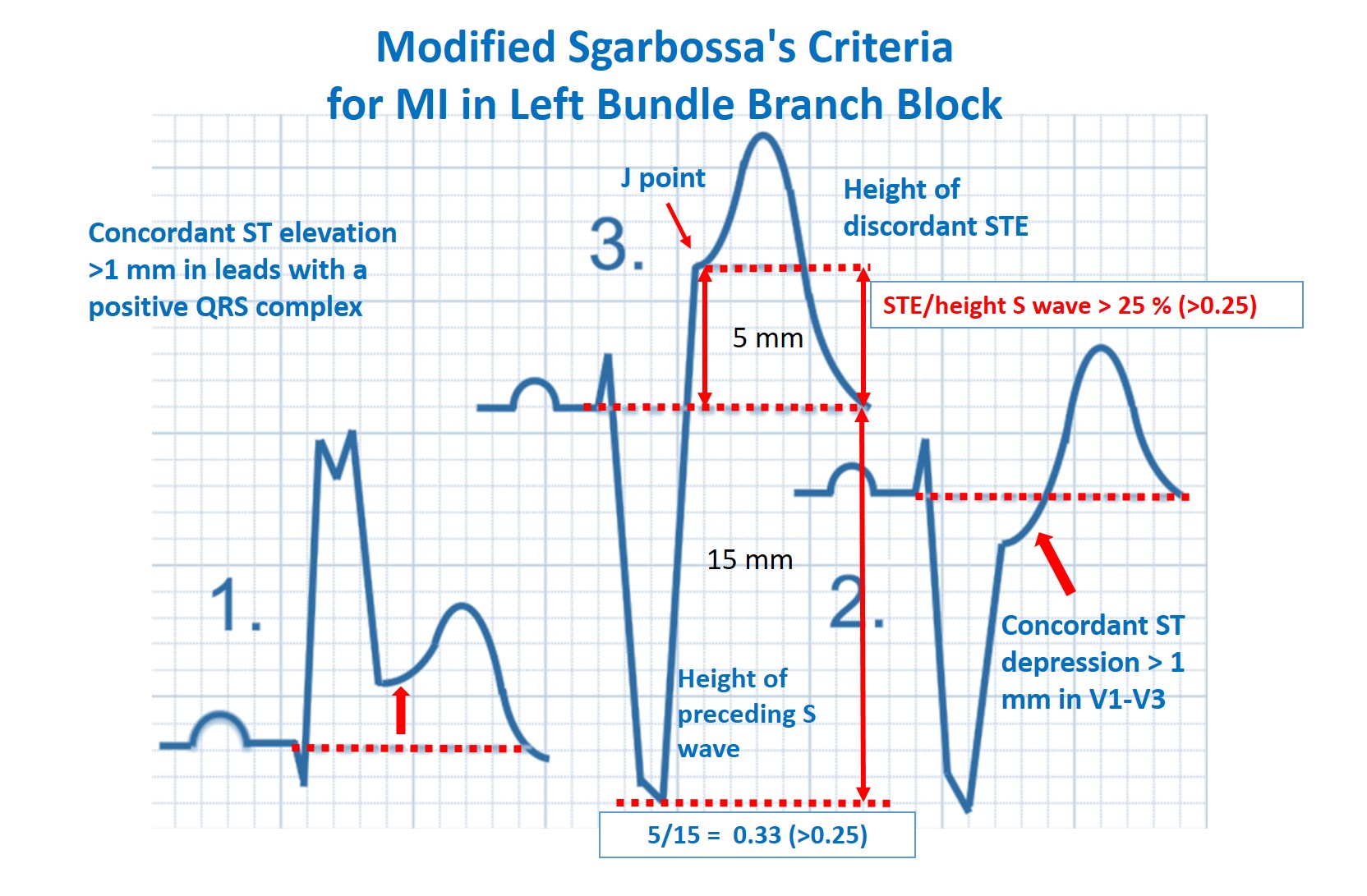2.
Fyziologické EKG
3.
EKG obraz základních patologií
4.
Poruchy srdečního rytmu - bradyarytmie
5.
Poruchy srdečního rytmu - tachyarytmie
6.
EKG u infarktu myokardu
7.
Kardiomyopatie, myokarditidy
8.
Pravostranné přetížení srdce
9.
Vrozené arytmické syndromy
10.
Ostatní (Iontové dysbalance, hypotermie a další)
11.
Kardiostimulace
Introduction
As the incidence of left bundle branch blocks (LBBBs) and ventricular paced-rhythms ECGs increase in the aging global population, the need for improved diagnosis of STEMI or STEMI equivalents in patients with these rhythms becomes more imperative.
Sgarbossa criteria were first described by dr. Elena B Sgarbossa in 1996.
Original criteria:
- Concordant ST elevation > 1mm in leads with a positive QRS complex (score 5)
- Concordant ST depression > 1 mm in V1-V3 (score 3)
- Excessively discordant ST elevation > 5 mm in leads with a negative QRS complex (score 2).
These criteria are specific, but not sensitive for myocardial infarction.
In the original Sgarbossa criteria, a score of <3 typically is not considered diagnostic of acute MI, but also does not rule out MI. A total score of ≥ 3 is reported to have a specificity of 90% for diagnosing myocardial infarction.
The Modified Sgarbossa Criteria (which changes the third criteria) does not use the points system, it is positive if any criteria are met.
Smith-modified Sgarbossa criteria
Have been created to improve diagnostic accuracy. The most important change is the modification of the rule for excessive discordance.
Increase sensitivity from 52% → 91% at the expense of reducing specificity from 98% → 90%.
- ≥1 mm of concordant ST elevation in any lead
- ≥ 1 mm of concordant ST depression in ≥ 1 lead V1-V3
- ≥ 1 lead anywhere with ≥ 1 mm STE and proportionally excessive discordant STE, as defined by ≥ 25% of the depth of the preceding S-wave

ECG 1 Positive Sgarbossa criteria in a patient with a ventricular paced rhythm (concordant ST elevations in I, aVL, V5-V6)

ECG 2 Anterior STEMI in LBBB (leads V1-V3 with ≥ 1 mm STE and proportionally excessive discordant STE, as defined by ≥ 25% of the depth of the preceding S-wave)

References
- Sefa N, Sawyer KN. Smith-Modified Sgarbossa Criteria and Paced Rhythms: A Case Report. J Emerg Med. 2016 Nov;51(5):584-588. doi: 10.1016/j.jemermed.2016.06.055. Epub 2016 Sep 8. PMID: 27618475.
- Smith SW, Dodd KW, Henry TD, Dvorak DM, Pearce LA. Diagnosis of ST-elevation myocardial infarction in the presence of left bundle branch block with the ST-elevation to S-wave ratio in a modified Sgarbossa rule. Ann Emerg Med. 2012 Dec;60(6):766-76. doi: 10.1016/j.annemergmed.2012.07.119. Epub 2012 Aug 31. Erratum in: Ann Emerg Med. 2013 Oct;62(4):302. PMID: 22939607.
- Sgarbossa EB, Pinski SL, Gates KB, and Wagner GS. Early electrocardiographic diagnosis of acute myocardial infarction in the presence of ventricular paced rhythm. GUSTO-I investigators. Am J Cardiol 1996 Feb 15; 77(5) 423-424
- Sgarbossa EB et al. Electrocardiographic diagnosis of evolving acute myocardial infarction in the presence of left bundle-branch block. GUSTO-1. N Engl J Med 1996 Feb 22; 334(8) 481-7
- https://wikem.org/wiki/Sgarbossa%27s_criteria

Introduction
As the incidence of left bundle branch blocks (LBBBs) and ventricular paced-rhythms ECGs increase in the aging global population, the need for improved diagnosis of STEMI or STEMI equivalents in patients with these rhythms becomes more imperative.
Sgarbossa criteria were first described by dr. Elena B Sgarbossa in 1996.
Original criteria:
- Concordant ST elevation > 1mm in leads with a positive QRS complex (score 5)
- Concordant ST depression > 1 mm in V1-V3 (score 3)
- Excessively discordant ST elevation > 5 mm in leads with a negative QRS complex (score 2).
These criteria are specific, but not sensitive for myocardial infarction.
In the original Sgarbossa criteria, a score of <3 typically is not considered diagnostic of acute MI, but also does not rule out MI. A total score of ≥ 3 is reported to have a specificity of 90% for diagnosing myocardial infarction.
The Modified Sgarbossa Criteria (which changes the third criteria) does not use the points system, it is positive if any criteria are met.
Smith-modified Sgarbossa criteria
Have been created to improve diagnostic accuracy. The most important change is the modification of the rule for excessive discordance.
Increase sensitivity from 52% → 91% at the expense of reducing specificity from 98% → 90%.
- ≥1 mm of concordant ST elevation in any lead
- ≥ 1 mm of concordant ST depression in ≥ 1 lead V1-V3
- ≥ 1 lead anywhere with ≥ 1 mm STE and proportionally excessive discordant STE, as defined by ≥ 25% of the depth of the preceding S-wave

ECG 1 Positive Sgarbossa criteria in a patient with a ventricular paced rhythm (concordant ST elevations in I, aVL, V5-V6)

ECG 2 Anterior STEMI in LBBB (leads V1-V3 with ≥ 1 mm STE and proportionally excessive discordant STE, as defined by ≥ 25% of the depth of the preceding S-wave)

References
- Sefa N, Sawyer KN. Smith-Modified Sgarbossa Criteria and Paced Rhythms: A Case Report. J Emerg Med. 2016 Nov;51(5):584-588. doi: 10.1016/j.jemermed.2016.06.055. Epub 2016 Sep 8. PMID: 27618475.
- Smith SW, Dodd KW, Henry TD, Dvorak DM, Pearce LA. Diagnosis of ST-elevation myocardial infarction in the presence of left bundle branch block with the ST-elevation to S-wave ratio in a modified Sgarbossa rule. Ann Emerg Med. 2012 Dec;60(6):766-76. doi: 10.1016/j.annemergmed.2012.07.119. Epub 2012 Aug 31. Erratum in: Ann Emerg Med. 2013 Oct;62(4):302. PMID: 22939607.
- Sgarbossa EB, Pinski SL, Gates KB, and Wagner GS. Early electrocardiographic diagnosis of acute myocardial infarction in the presence of ventricular paced rhythm. GUSTO-I investigators. Am J Cardiol 1996 Feb 15; 77(5) 423-424
- Sgarbossa EB et al. Electrocardiographic diagnosis of evolving acute myocardial infarction in the presence of left bundle-branch block. GUSTO-1. N Engl J Med 1996 Feb 22; 334(8) 481-7
- https://wikem.org/wiki/Sgarbossa%27s_criteria






